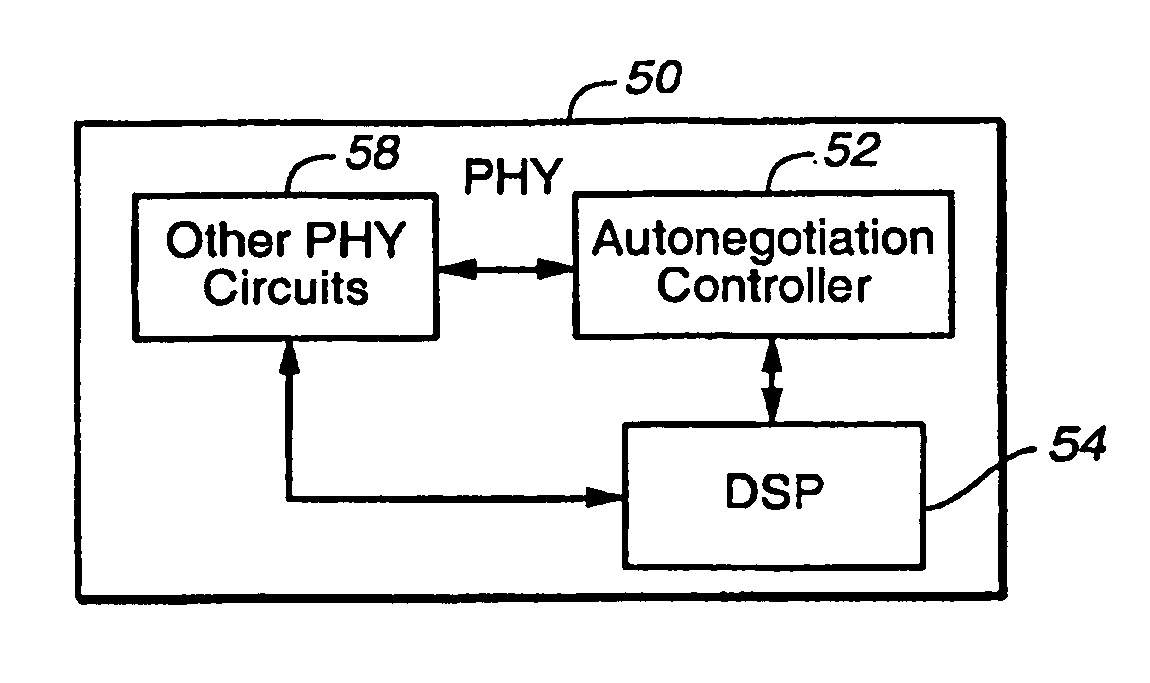Method and apparatus for autonegotiation between network devices
a network device and autonegotiation technology, applied in the field of autonegotiation controllers, can solve the problems of requiring an external power supply and being costly
- Summary
- Abstract
- Description
- Claims
- Application Information
AI Technical Summary
Benefits of technology
Problems solved by technology
Method used
Image
Examples
first embodiment
[0082]The following is a detailed description for detecting whether the connected network device 12 (12′) is a cable-powered DTE device or self-powered DTE device. In network device 10, signal generator 322 generates test signals for transmission by transmitter 312 over pair A of data cable 18, the test signal returns through filter 18 and pair B of data cable 18, receiver 314 to detector 324. If the network device 12′ is a self-powered DTE device, as shown in FIG. 2B, or if there is an open circuit, detector 324 does not detect a return signal. As a result power is not supplied by network device 10 to network device 12′ over data cable 18.
[0083]Referring to FIG. 3A, an exemplary test signal generated by signal generator 322 comprising plural pulses is illustrated. An initial pulse having a magnitude of −1 volt is applied for 752 ns followed by, positive pulses (1 volt) having a width of about 152 ns, negative (−1 volt) pulses having a width of approximately 72 ns and ending with a ...
second embodiment
[0092]Referring to FIG. 3B, an exemplary test signal generated by signal generator 322 comprising plural pulses in accordance with the second embodiment is illustrated. The width of each positive pulse is about 150 ns, and the width of each negative pulse is approximately 70 ns. Successive test signals are spaced by at least 156 ms. When a cable powered DTE requiring power is not already being supplied with power, signal generator 322 generates test signals for transmission by transmitter 312 over pair A of data cable 18. The test signal returns through filter 18 and pair B of data cable 18, receiver 314 to detector 324. If the network device 12′ is a self-powered DTE device or there is an open circuit, as shown in FIG. 2B, detector 324 does not detect a return signal. As a result power is not supplied by network device 10 to network device 12′ over data cable 18.
[0093]FIG. 4B illustrates the test signal received by detector 324 when the length of the data cable is approximately zer...
PUM
 Login to View More
Login to View More Abstract
Description
Claims
Application Information
 Login to View More
Login to View More - R&D
- Intellectual Property
- Life Sciences
- Materials
- Tech Scout
- Unparalleled Data Quality
- Higher Quality Content
- 60% Fewer Hallucinations
Browse by: Latest US Patents, China's latest patents, Technical Efficacy Thesaurus, Application Domain, Technology Topic, Popular Technical Reports.
© 2025 PatSnap. All rights reserved.Legal|Privacy policy|Modern Slavery Act Transparency Statement|Sitemap|About US| Contact US: help@patsnap.com



